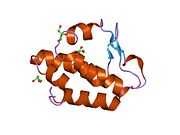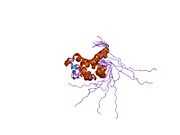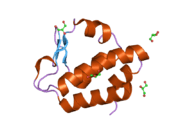NGLY1
| N-glycanase 1 | |||||||||||||
|---|---|---|---|---|---|---|---|---|---|---|---|---|---|
 PDB rendering based on 2ccq. | |||||||||||||
| |||||||||||||
| Identifiers | |||||||||||||
| Symbols | NGLY1 ; CDG1V; PNG1; PNGase | ||||||||||||
| External IDs | OMIM: 610661 MGI: 1913276 HomoloGene: 10117 GeneCards: NGLY1 Gene | ||||||||||||
| EC number | 3.5.1.52 | ||||||||||||
| |||||||||||||
| RNA expression pattern | |||||||||||||
 | |||||||||||||
| More reference expression data | |||||||||||||
| Orthologs | |||||||||||||
| Species | Human | Mouse | |||||||||||
| Entrez | 55768 | 59007 | |||||||||||
| Ensembl | ENSG00000151092 | ENSMUSG00000021785 | |||||||||||
| UniProt | Q96IV0 | Q9JI78 | |||||||||||
| RefSeq (mRNA) | NM_001145293 | NM_021504 | |||||||||||
| RefSeq (protein) | NP_001138765 | NP_067479 | |||||||||||
| Location (UCSC) | Chr 3: 25.76 – 25.83 Mb | Chr 14: 16.25 – 16.31 Mb | |||||||||||
| PubMed search | |||||||||||||
Peptide-N(4)-(N-acetyl-beta-glucosaminyl)asparagine amidase is an enzyme that in humans is encoded by the NGLY1 gene.[1]
Function
This gene encodes an enzyme that catalyzes hydrolysis of an N(4)-(acetyl-beta-D-glucosaminyl) asparagine residue to N-acetyl-beta-D-glucosaminylamine and a peptide containing an aspartate residue. The encoded enzyme may play a role in the proteasome-mediated degradation of misfolded glycoproteins.[1]
Clinical significance
In 2012, by means of exome sequencing it was determined that a genetic mutation of the NGLY1 gene, resulting in inability to synthesise this enzyme, is the cause of an extremely rare congenital disorder of glycosylation variant.[2]
In 2014, a study of eight recently discovered patients with mutations in the NGLY1 gene established a phenotype for NGLY1 deficiency.[3] NGLY1 deficiency is characterized by global developmental delay (often severe), neurological impairment, movement disorder and hypotonia. Almost all patients have difficulty producing tears and present abnormally on EEGs.
The site ngly1.org serves as a hub for N-Glycanase deficient patients. The Grace Wilsey Foundation (gracewilsey.org) has been established to raise awareness and support research.
References
- ↑ 1.0 1.1 "Entrez Gene: NGLY1 N-glycanase 1".
- ↑ Need AC, Shashi V, Hitomi Y, Schoch K, Shianna KV, McDonald MT, Meisler MH, Goldstein DB (May 2012). "Clinical application of exome sequencing in undiagnosed genetic conditions". J Med Genet 49 (6): 353–61. doi:10.1136/jmedgenet-2012-100819. PMC 3375064. PMID 22581936.
- ↑ Enns GM, Shashi V, Bainbridge M et al. (March 2014). "Mutations in NGLY1 cause an inherited disorder of the endoplasmic reticulum-associated degradation pathway". Genet. Med. 16 (10): 751–8. doi:10.1038/gim.2014.22. PMID 24651605.
Further reading
- Suzuki T, Park H, Hollingsworth NM et al. (2000). "PNG1, a Yeast Gene Encoding a Highly Conserved Peptide:N-Glycanase". J. Cell Biol. 149 (5): 1039–52. doi:10.1083/jcb.149.5.1039. PMC 2174826. PMID 10831608.
- Park H, Suzuki T, Lennarz WJ (2001). "Identification of proteins that interact with mammalian peptide:N-glycanase and implicate this hydrolase in the proteasome-dependent pathway for protein degradation". Proc. Natl. Acad. Sci. U.S.A. 98 (20): 11163–8. doi:10.1073/pnas.201393498. PMC 58701. PMID 11562482.
- Strausberg RL, Feingold EA, Grouse LH et al. (2003). "Generation and initial analysis of more than 15,000 full-length human and mouse cDNA sequences". Proc. Natl. Acad. Sci. U.S.A. 99 (26): 16899–903. doi:10.1073/pnas.242603899. PMC 139241. PMID 12477932.
- Ota T, Suzuki Y, Nishikawa T et al. (2004). "Complete sequencing and characterization of 21,243 full-length human cDNAs". Nat. Genet. 36 (1): 40–5. doi:10.1038/ng1285. PMID 14702039.
- Blom D, Hirsch C, Stern P et al. (2005). "A glycosylated type I membrane protein becomes cytosolic when peptide: N-glycanase is compromised". EMBO J. 23 (3): 650–8. doi:10.1038/sj.emboj.7600090. PMC 1271816. PMID 14749736.
- Katiyar S, Li G, Lennarz WJ (2004). "A complex between peptide:N-glycanase and two proteasome-linked proteins suggests a mechanism for the degradation of misfolded glycoproteins". Proc. Natl. Acad. Sci. U.S.A. 101 (38): 13774–9. doi:10.1073/pnas.0405663101. PMC 518832. PMID 15358861.
- McNeill H, Knebel A, Arthur JS et al. (2005). "A novel UBA and UBX domain protein that binds polyubiquitin and VCP and is a substrate for SAPKs". Biochem. J. 384 (Pt 2): 391–400. doi:10.1042/BJ20041498. PMC 1134123. PMID 15362974.
- Gerhard DS, Wagner L, Feingold EA et al. (2004). "The Status, Quality, and Expansion of the NIH Full-Length cDNA Project: The Mammalian Gene Collection (MGC)". Genome Res. 14 (10B): 2121–7. doi:10.1101/gr.2596504. PMC 528928. PMID 15489334.
- Misaghi S, Pacold ME, Blom D et al. (2005). "Using a small molecule inhibitor of peptide: N-glycanase to probe its role in glycoprotein turnover". Chem. Biol. 11 (12): 1677–87. doi:10.1016/j.chembiol.2004.11.010. PMID 15610852.
- Katiyar S, Joshi S, Lennarz WJ (2006). "The Retrotranslocation Protein Derlin-1 Binds Peptide:N-Glycanase to the Endoplasmic Reticulum". Mol. Biol. Cell 16 (10): 4584–94. doi:10.1091/mbc.E05-04-0345. PMC 1237066. PMID 16055502.
- Allen MD, Buchberger A, Bycroft M (2006). "The PUB domain functions as a p97 binding module in human peptide N-glycanase". J. Biol. Chem. 281 (35): 25502–8. doi:10.1074/jbc.M601173200. PMID 16807242.
- Altrich-VanLith ML, Ostankovitch M, Polefrone JM et al. (2007). "Processing of a class I-restricted epitope from tyrosinase requires peptide N-glycanase and the cooperative action of endoplasmic reticulum aminopeptidase 1 and cytosolic proteases". J. Immunol. 177 (8): 5440–50. doi:10.4049/jimmunol.177.8.5440. PMID 17015730.
| |||||||||||||||||
This article incorporates text from the United States National Library of Medicine, which is in the public domain.




